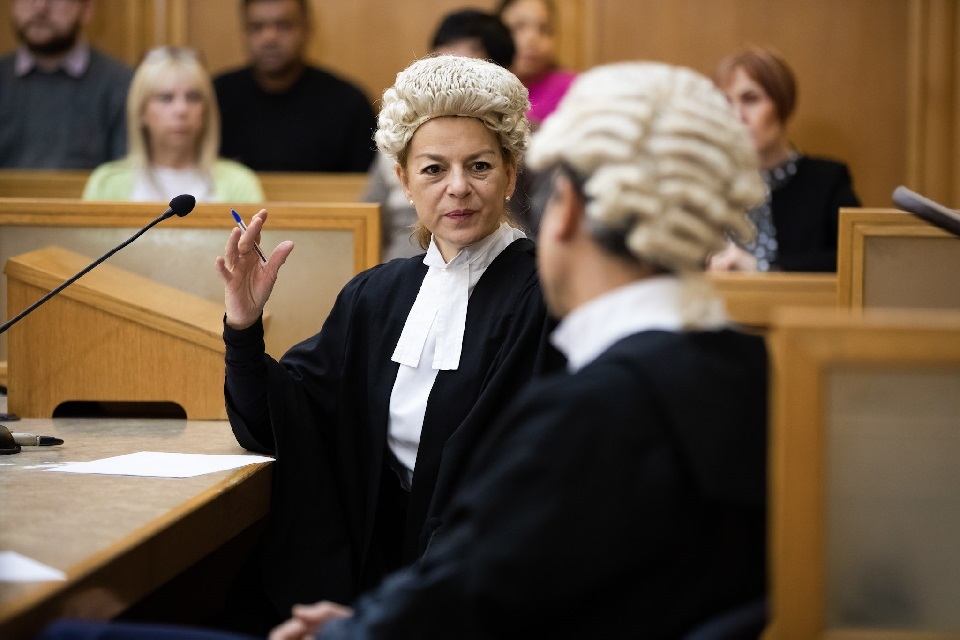Chief executive Susan Acland-Hood tells Richard Johnstone how the agency’s £1bn reform plan will deliver a better justice system
Photo: Paul Heartfield
Susan Acland-Hood is, she insists, quite comfortable in her hammock. This might seem like an unusual place for a senior government official to be, but this is how the chief executive of HM Courts and Tribunals Service – in one of the best Whitehall analogies we have heard in a while – describes the rather odd position of her agency.
“HMCTS is unique in being run jointly by the executive and the judiciary, so I report jointly to the lord chancellor and the lord chief justice,” she explains. “When I started last November, lots of people described this to me as sitting on a two-legged stool – you are actively keeping your balance.
“But having reflected on this carefully over recent months, I chose a different metaphor. It is more like lying in a hammock – it is different from a normal bed, it feels a little bit freer in a lot of ways, there’s a little bit more movement there, but it is actually quite comfortable and quite appealing unless you have any doubt about the security with which your hammock is attached at each end. And you only need the hammock to feel like it is coming loose at one end for it to stop being comfortable and appealing and to start being a bit worrying.
“At the moment, I feel very secure in my hammock and I spend a lot of time attending to the knots at each end of it and making sure the relationship is secure.”
Despite this lounging metaphor, Acland-Hood is most certainly not relaxing in the job. When she took over as the head of HMCTS, she inherited a £1bn reform plan for courts and tribunals in England and Wales that could transform many centuries-old practices of the law.
Under the scheme, HMCTS is working to create what Acland-Hood calls the online court, intended to make the operation of criminal, civil and family courts and tribunal cases much more efficient. Many elements of these reforms – which range from creating an online platform for the police to share details of criminal charges with the Crown Prosecution Service and HMCTS, to an electronic rota for magistrates and even an online system for divorce proceedings – are now moving into beta testing.
Related content
- Digitisation of the court system must not decrease access to justice
- Interview: The Crown Prosecution Service’s digital transformation chief on his ‘user-centric’ mission
- Courts service hunts for ‘upfront and honest’ delivery partner on digital reforms
“We’re just at the stage where it has stopped being a thing that we wrote down on a piece of paper and started to be a thing that we are doing, and there are a lot of things that people will start to see quite soon,” Acland-Hood says.
The opportunity to make such a major change is what attracted Acland-Hood to the role. “I’ve spent quite a lot of my career finding things that people thought were very hard and then trying to do them,” she says.
This career has included a stint serving as director of enterprise and growth at the Treasury as well as head of strategy at the Home Office and home affairs and justice private secretary to Gordon Brown when he was prime minister. Through all these roles, Acland-Hood says she has “always been interested in trying to find a small number of big things that make a big difference” – a description that neatly fits the court reform plans.
“I think it is quite easy to spend your career doing a large number of small things,” she explains. “And sometimes you make a lot of progress by doing a large number of small things, but I think you always have to ask yourself the question: ‘are we missing the big lever, are we missing the strategic change we could make?’ So I am always trying to do that.”
Her time at the Treasury presented lots of opportunities to make big changes, she says, such as helping to set up the apprenticeship levy and hypothecating vehicle excise duty to fund roads. Now, at HMCTS, she is continuing with her aim of finding big changes that transform rather than small changes which merely improve.
Court estate plan
The digital courts transformation programme is part-funded by reducing the size of the court estate, and Acland-Hood sets out the plans in two stages. The first is making the most efficient use of the existing caseload, while in the second round the new digital system will be helping to reduce the number of cases.
“We are already in the process of closing around 117 court buildings, and that programme is going pretty well. We have good plans that have already been executed or are in the course of being executed to make sure we’re able to move work from the buildings that are closing down to other buildings and accommodate it,” Acland-Hood says.
“We have quite a lot of towns where we have several buildings more or less within sight of each other that have grown up though the heritage of HMCTS. Quite a lot of the closures that we undertake are about going from having four buildings in one town to having two, and working out how we can fit the work in, and that seems to me to be eminently sensible good management.”
A second stage will come when there are clear signs that digital improvements are reducing the number of cases that need to be heard in court, therefore freeing up even more capacity.
“As we go through the reform we will find different ways for people to access justice, and fewer cases will need to come a physical hearing in a physical court building” she says.
“And as we do that, the opportunity to think again about how we can close more court buildings will arise. What we have said is we will frontload the change to technology and ways of working, and backload the estate changes, so we will try and demonstrate we can take that work of out of the estate before we start closing buildings.”
She visits a court every week and says the current system means “a huge amount of effort goes into continuous improvement and small changes applied on a system that has some fundamentally broken national processes”.
“People are spending a lot of discretionary effort figuring out how to move lots and lots of paper from point A to point B more efficiently than they did it yesterday, and how to make sure we don’t lose quite as many pieces of paper as we did last week and so on,” she says.
“That effort is taking us from not really very good to just about all right, and that is an unfair reflection of the effort and the will people are putting in to try and make the system work. So for me, the core of the HMCTS reform programme is that we have £1bn to fundamentally transform how the system works across all jurisdictions. It is about trying to get us to a place where we have really good national systems and processes and then people’s discretionary effort is placed on top of them to go from good to great.”
Appealing work
Some of these reforms will improve effectiveness behind the scenes, such as digital recording of decisions from magistrates’ courts, or the initial building blocks for a digital criminal charging system. Others, however, are more public facing.
For example, HMCTS has just launched beta versions of an online system that allows citizens to check the status of appeals against tax bills and benefit decisions, and Acland-Hood highlights an online system for civil claims as a prime example of where the reforms can lead.
“This is probably the most exciting bit of what we’re doing – it doesn’t sound very promising but it really is,” says Acland-Hood.
Take an example of someone wanting to sue their plumber over a bath being put in the wrong way.
Currently, a web system allows people to input the initial basis of their claim – “we’ve just turned our paper form into an online form, and it is still a very confusing and complicated document that many people can’t understand”, says Acland-Hood. Soon, a new bespoke system will instead help people through the process. It will ask the claimant what someone owes, what happened and its impact on them, and it then allows the parties to be contacted.
Initially, HMCTS designed the system to issue a claim, but user testing found demand for it to allow for negotiations to resolve disputes.
“One of the things we know is that quite a lot of people don’t really want to go to court, they want to try and fix the problem,” says Acland-Hood. “What users told us in testing was that they really wanted a system that let them have a sensible exchange with the other person to try and agree between them, in a structured process where they feel safe and know if they reach a conclusion it would be honoured.”
The core is thinking about justice in a different way and not assuming that the right answer to every dispute is a physical hearing in a physical court
“So we built a system that lets them go through that dialogue – the builder says, ‘I don’t think I owe you £5,000 but I accept that your bath wasn’t put in brilliantly so how about I give £2,500’. If you are happy to say yes to that, then the system will generate a legally binding form that is actionable.”
This illustrates how technology could change decisions across a whole range of disputes – and potentially free up a lot of court buildings in the process (see box above).
“It is the first building block in what is quite often described as the online court,” says Acland-Hood. “It is not doing everything the online court would do yet, but you can see the way we can create a pathway that would let you build a case in a way that was well-structured and would also allow a judge, if they wanted to, to make a decision on the facts of your case and talk to you in real time though an instant messenger. Lots of decisions could be made much more quickly, and people could get their issues sorted out much more easily.”
A pathway to apply this approach across civil, family and tribunal cases has been agreed with the judiciary, and she says this constitutes the most exciting bit of the programme.
“The core is thinking about justice in a different way and not assuming that the right answer to every dispute is a physical hearing in a physical court, where you need to fit in with us. It might be something that is much fleeter of foot.”
These reforms are intended to not just make the court system more efficient, she says, but to improve access to justice in the first place.
“There is a whole set of things that impede people’s access to justice, which stem from how they feel about the process,” Acland-Hood explains. “If we can give those people a route that is quick and simple and easy, that potentially helps them get things sorted out at an early stage, in a relatively simple way, then I think we will start to transform the landscape.”
It is this chance to make that major difference that clearly motivates Acland-Hood – court reform is certainly a “big thing” that matches her ambitions.
Observing progress from her hammock at the heart of this complex programme, Acland-Hood sums up why she is enjoying it so much:
“There is an amazing combination here of an incredibly essential piece of our constitutional set-up, and a really big opportunity to make change and reform.”



